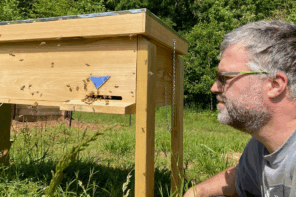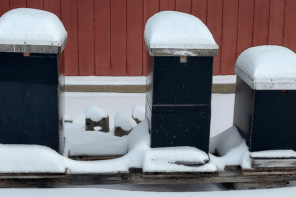By: Robert Weast
This article originally appeared in the Spring 2019 issue of BEEKeeping Your First Three Years
Honey Containers Can Both Preserve or Induce Spoilage
Why is there an interest in collecting ancient honey pots? A prime reason may be the historical connection, touching base with a bygone era. Archeologists have uncovered entire ancient villages, revealing a treasure trove of valuable artifacts. Honey containers found in the diggings would be priceless and sought after by collectors. Holding, viewing, and touching an ancient honey pot personalizes and produces an intimate connection to times past. One might enjoy collecting contemporary honey pots because they may be nostalgic, recalling an event in one’s life, be it a serendipitous, pleasant experience, or a calamitous, unpleasant occurrence.
Every conceivable shape of container or dispenser imaginable has stored honey during the past several millennia beginning with primitive harvesters made by honey robbers who cut combs from wild colonies. Presumably they protected their harvest as best they could from vermin, which must have taken some ingenuity. Today, containers range from large storage tanks to earthen, clay vessels, from plain and glazed pottery to glassware, not to mention the ubiquitous handy plastic honey bear dispensers. Honey pots have become collectibles and occur in an infinite variety of styles. Some rise to icon status, works of artistry; from the potter’s wheel and adorned by skilled hands. These gems are ornate and are admired for their beauty, not necessarily used for dispensing honey.
The most primitive honey holders I have seen were at trinket, souvenir and fruit stands in Kenya. On an African safari our bus stopped at roadside stands in villages, where small slabs of comb drenched in liquid honey were sold in any sort of makeshift take-home containers. The imagination and adaptability of local beekeepers kept package expenses down to a bare minimum, or even zero. They recycled what they had on hand. Coke bottles are commonly repurposed for liquid honey.
It is well known that honey seems to be imperishable when sealed and protected from moisture. The most famous example of preserved honey dates back 3,000 years to ancient Egypt. In 1922 the tomb of King Tutankhamun, simply known as King Tut, was unearthed from the sand in Egypt’s Valley of the Kings. Among priceless jewels and gold was a cache of honey, still edible and delicious after three millennia. A most remarkable discovery!
Ancient Egyptians used honey as an antiseptic ointment. Because honey is extremely acidic and devoid of moisture, bacteria and other organisms are prevented from growing, making honey an efficient, and ancient remedy to help prevent infections of flesh wounds. In addition, when bees regurgitate nectar, the enzyme glucose oxidase is present, which breaks down into minute amounts of hydrogen peroxide when diluted by wound exudates. This continuous production of hydrogen peroxide fights infections. Even today, manuka honey from New Zealand is noted for its elevated levels of heat stable methylglyoxal with its high antibacterial activity against E. coli and S. aureum. Manuka honey fetches a premium price, depending on its activity level. In my local store it ranges from a low of $38 up to $114 for 8.8 oz.
Honey spoilage is traceable to moisture. Honey is hygroscopic, that is, it attracts and absorbs moisture; hence, naturally occurring yeasts can consume the sugars, producing alcohol that cause the honey to ferment. Uncovered honey is a recipe for eventual spoilage, especially during periods of high temperatures coupled with high humidity. Another prescription for spoilage occurs when high water-laden nectar is deposited in the comb. Typically, bees will fan air over these combs to remove the excess moisture. Should the bees vacate the unsealed comb before this moisture is removed, fermentation can set in. This phenomenon also occurs when beekeepers store unripe, uncapped honey in combs.
Typically honey bees preserve their cured honey by covering the comb cells with wax. Sealing the combs has two purposes: It prevents honey from dripping out and thwarts ants and other vermin from feasting on the hard earned treasure.
Whatever the type of prolonged honey storage used, the cardinal rule is that the container must be perfectly sealed from outside, ambient air. Honey pots, when used as short term dispensers of honey, are fine because consumption ensures that they are periodically emptied of their golden and amber tasty contents.
Sources for honey pots can be just about anywhere, from antique shops, garage sales, flea markets to online, where dozens are for sale. If you’re interested in collecting them, always keep your eyes open. Contemporary honey pots are reasonably price, but old or ancient honey pots are rare and command a premium price. Now, where shall I store my latest acquisition…







